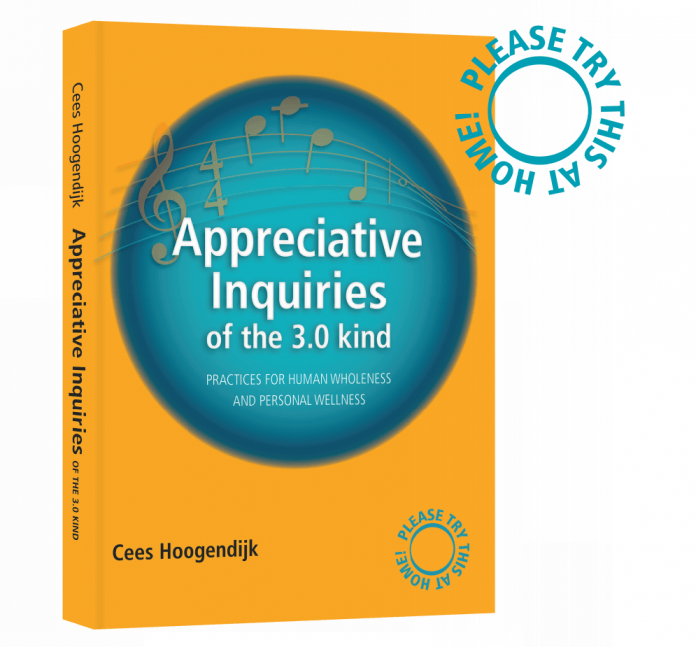[from book part 2 WHEN THE BEGINNING STARTS TO BEGIN]
Okay, let’s consider the former chapters as a ‘warm-up’ or perhaps as first exercises. Appreciate this book just as you like. Although every chapter has a number to it, you can choose your own reading order; or pick out what appeals to you. So why does every chapter have a number? That’s because there is a kind of logic in the construction of this book. It follows the path of the AI100 action learning program (you can read about it in the introduction by co-founder Marcel van Marrewijk).
It took a few years of puzzling on how to arrange all the topics in this learning course. Yet we’re still not totally sure whether to start or to end with the basic principles of social construction; whether to do practical stuff first and the theory afterwards, or the other way round. Nevertheless, the structure of the AI100-course inspired the collation of this book. Does that turn this into a textbook?
Once you grasp an AI-activity, you’re a practitioner all right. But there’s a big chance that in the next minute, you want to know what you did, and why it worked (or did not). The question is: do you want this book to be your guide in a learning process? It definitely can be used that way. It has been written based on many experiences out of a learning program. Do you want to skip sections? Feel free, and maybe the book will see you back later. Still interested in the main structure? Here it is.
As said before, the Preludes are little acquaintances even before the study begins.
The next section 3 is called Sources of Social Construction. Do you need this for the purpose of studying AI? Not necessarily. But at some point at being an AI enthusiastic, you might want to find out what kind of thinking has led to what we now call Appreciative Inquiry. You will notice that this thinking has roots far away in the past and at the same time very nearby in a fine small country called Belgium. The journey of AI starts often by encountering an AI source. My choice of ‘sources’ is a personal one. The section is meant for honoring and admiring and referring.
Section 4 is called Social Construction. The chapters lead you along underlying and associating principles of Appreciative Inquiry. This might seem purely theoretical, but don’t get me wrong; social construction is preferably something we do.
Being a participant of an AI summit doesn’t necessarily demand any knowledge or experience in AI, but attending a summit can make you curious. Section 5 ‘Who am I to Appreciate?’ Invites you to inquire about yourself from the perspective of being an AI apprentice – which I still am. What does it take to (further) develop yourself as an AI-person?
Where we let our students dive into a two days ‘AI Summit’, section 6 My Next AI Summit intends to do the same. What is this multi-stakeholder practice around Discovering, Dreaming, Designing and Delivery, that makes it so accessible and powerful? Take the plunge.
Section 7 is called Appreciate YourSelf. Compared to the ‘what should I do?’ question in the section before, you could ask yourself ‘how (appreciative) am I?’, and is it possible to influence your own ‘ground state’?
The basic ingredient of Appreciative Inquiry is ‘high quality communication’. Titled The Art of Inquiry, section 8 is about what can happen (and happens) in the conversation between two people, and how your ability to ask questions can enable the empowerment of the other. ‘Can I start with section 8?’ you might ask. Please do.
From being participant in AI-circumstances to being the one to perform Appreciative Inquiry to others – there’s more. Section 9 CFO in Appreciation addresses the possible role of the facilitator of the AI-process of others, mostly groups. This is about designing an AI-summit of another form of a constructive meeting. Try this at home? If you have a large family, yes.
Section 10 Encountering Complexity brings you within the organizational context. What is it like to intervene in such a ‘chaordic’ system? Are you making it a better place? If you recognize the familiarities in your work, then please try this knowledge ‘at your home base at work’.
In following these sections, in theory you are following – more or less – our learning program. That is: without the fellow students, without the highly experienced teachers. Please find others to join you. The last sections 11 Further Reading and 12 How to Proceed try to give you some extra support.
Thus far you have followed the structured approach of this book, so please forget everything you’ve just read. Celebrate faith. Choose a random page and start (or continue) your journey. If you wish, explore www.appreciativeinquiries.eu and leave your comments and suggestions. It’s highly appreciated!
In the past year, what did you learn or study to become a better person?
What exactly is your best learning style?
In the coming year, which of your skills or talents you would like to explore somewhat more?
You’ve just read one of the 110 chapters of my book Appreciative Inquiries of the 3.0 Kind. Find out more (and a special pre-ordering offer) on www.appreciativeinquiries.eu.












